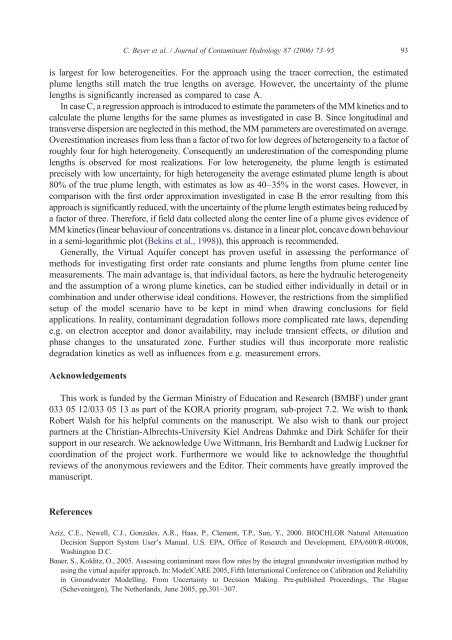Applied numerical modeling of saturated / unsaturated flow and ...
Applied numerical modeling of saturated / unsaturated flow and ...
Applied numerical modeling of saturated / unsaturated flow and ...
Create successful ePaper yourself
Turn your PDF publications into a flip-book with our unique Google optimized e-Paper software.
is largest for low heterogeneities. For the approach using the tracer correction, the estimated<br />
plume lengths still match the true lengths on average. However, the uncertainty <strong>of</strong> the plume<br />
lengths is significantly increased as compared to case A.<br />
In case C, a regression approach is introduced to estimate the parameters <strong>of</strong> the MM kinetics <strong>and</strong> to<br />
calculate the plume lengths for the same plumes as investigated in case B. Since longitudinal <strong>and</strong><br />
transverse dispersion are neglected in this method, the MM parameters are overestimated on average.<br />
Overestimation increases from less than a factor <strong>of</strong> two for low degrees <strong>of</strong> heterogeneity to a factor <strong>of</strong><br />
roughly four for high heterogeneity. Consequently an underestimation <strong>of</strong> the corresponding plume<br />
lengths is observed for most realizations. For low heterogeneity, the plume length is estimated<br />
precisely with low uncertainty, for high heterogeneity the average estimated plume length is about<br />
80% <strong>of</strong> the true plume length, with estimates as low as 40–35% in the worst cases. However, in<br />
comparison with the first order approximation investigated in case B the error resulting from this<br />
approach is significantly reduced, with the uncertainty <strong>of</strong> the plume length estimates being reduced by<br />
a factor <strong>of</strong> three. Therefore, if field data collected along the center line <strong>of</strong> a plume gives evidence <strong>of</strong><br />
MM kinetics (linear behaviour <strong>of</strong> concentrations vs. distance in a linear plot, concave down behaviour<br />
in a semi-logarithmic plot (Bekins et al., 1998)), this approach is recommended.<br />
Generally, the Virtual Aquifer concept has proven useful in assessing the performance <strong>of</strong><br />
methods for investigating first order rate constants <strong>and</strong> plume lengths from plume center line<br />
measurements. The main advantage is, that individual factors, as here the hydraulic heterogeneity<br />
<strong>and</strong> the assumption <strong>of</strong> a wrong plume kinetics, can be studied either individually in detail or in<br />
combination <strong>and</strong> under otherwise ideal conditions. However, the restrictions from the simplified<br />
setup <strong>of</strong> the model scenario have to be kept in mind when drawing conclusions for field<br />
applications. In reality, contaminant degradation follows more complicated rate laws, depending<br />
e.g. on electron acceptor <strong>and</strong> donor availability, may include transient effects, or dilution <strong>and</strong><br />
phase changes to the un<strong>saturated</strong> zone. Further studies will thus incorporate more realistic<br />
degradation kinetics as well as influences from e.g. measurement errors.<br />
Acknowledgements<br />
This work is funded by the German Ministry <strong>of</strong> Education <strong>and</strong> Research (BMBF) under grant<br />
033 05 12/033 05 13 as part <strong>of</strong> the KORA priority program, sub-project 7.2. We wish to thank<br />
Robert Walsh for his helpful comments on the manuscript. We also wish to thank our project<br />
partners at the Christian-Albrechts-University Kiel Andreas Dahmke <strong>and</strong> Dirk Schäfer for their<br />
support in our research. We acknowledge Uwe Wittmann, Iris Bernhardt <strong>and</strong> Ludwig Luckner for<br />
coordination <strong>of</strong> the project work. Furthermore we would like to acknowledge the thoughtful<br />
reviews <strong>of</strong> the anonymous reviewers <strong>and</strong> the Editor. Their comments have greatly improved the<br />
manuscript.<br />
References<br />
C. Beyer et al. / Journal <strong>of</strong> Contaminant Hydrology 87 (2006) 73–95<br />
Aziz, C.E., Newell, C.J., Gonzales, A.R., Haas, P., Clement, T.P., Sun, Y., 2000. BIOCHLOR Natural Attenuation<br />
Decision Support System User's Manual. U.S. EPA, Office <strong>of</strong> Research <strong>and</strong> Development, EPA/600/R-00/008,<br />
Washington D.C.<br />
Bauer, S., Kolditz, O., 2005. Assessing contaminant mass <strong>flow</strong> rates by the integral groundwater investigation method by<br />
using the virtual aquifer approach. In: ModelCARE 2005, Fifth International Conference on Calibration <strong>and</strong> Reliability<br />
in Groundwater Modelling. From Uncertainty to Decision Making. Pre-published Proceedings, The Hague<br />
(Scheveningen), The Netherl<strong>and</strong>s, June 2005, pp.301–307.<br />
93

















